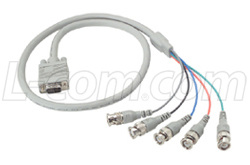An Insight within the Rising Significance of SVGA Cables
SVGA (Super Video Graphics Array) was the successor to the VGA (Video Graphics Adapter) interface. It's increasingly become an umbrella name for a variety of graphics standards which are widespread around the world. SVGA is still used extensively as a means of linking Personal computers as well as laptops to a computer monitor. SVGA facilitates a screen resolution of 1024*768, 8-bit pixels and this interface employs a 15-pin pinout.
Even though VGA cabling might also use a 15-pin format, they are not the same as the SVGA pinout. In reality, the actual VGA pinout is now obsolete.
It should be noted that SVGA pinouts do not make use of all fifteen pins. Rather, most are only 8 pin loaded. This is changing and it can now be seen that a few SVGA cables are utilising more of the pins giving an improved graphical image. The norm for SVGA was originally classified as an 800*600 resolution but was subsequently up scaled to a screen resolution of 1024*768, which was 8-bit. Just what this meant for the customer was a 256-colour option.
Naturally, technological advancements have led to these numbers becoming insignificant because colour shading is now controlled by modifications in the analogue voltage. It does this by using an SVGA graphics card interface that offers a limitless quantity of colour options dependant upon the abilities of this graphics card and memory space. Consequently, despite the fact that SVGA will give you an unlimited variety, you might still only be able to display 256 colours on account of various other devices in the chain.
Frequently it's simple to forget how much SVGA equipment still plays an integral part in modern-day living. Even though everybody raves about both HDMI and DVI, SVGA is still used each day by a substantial proportion of individuals via their computers not to mention the fact that there are many home appliances which use SVGA connections. Some televisions as well as home projectors to identify just some might still mainly use this format.
If you have 1 source (such as a personal computer or projector) but would like to present the image on two monitors or televisions then a VGA splitter might be the solution. What this does is literally split the signal in two displaying multiple versions of the same image. This could be adapted to incorporate large banks of displays if so desired.
One thing to try to remember is the fact that whatever sort of SVGA cable or accessory is required; always select one that's been produced from premium quality products that are much more probable to endure the test of time. Better constituents signify much better overall quality, especially if they've been created by a dependable source.
Even though VGA cabling might also use a 15-pin format, they are not the same as the SVGA pinout. In reality, the actual VGA pinout is now obsolete.
It should be noted that SVGA pinouts do not make use of all fifteen pins. Rather, most are only 8 pin loaded. This is changing and it can now be seen that a few SVGA cables are utilising more of the pins giving an improved graphical image. The norm for SVGA was originally classified as an 800*600 resolution but was subsequently up scaled to a screen resolution of 1024*768, which was 8-bit. Just what this meant for the customer was a 256-colour option.
Naturally, technological advancements have led to these numbers becoming insignificant because colour shading is now controlled by modifications in the analogue voltage. It does this by using an SVGA graphics card interface that offers a limitless quantity of colour options dependant upon the abilities of this graphics card and memory space. Consequently, despite the fact that SVGA will give you an unlimited variety, you might still only be able to display 256 colours on account of various other devices in the chain.
Frequently it's simple to forget how much SVGA equipment still plays an integral part in modern-day living. Even though everybody raves about both HDMI and DVI, SVGA is still used each day by a substantial proportion of individuals via their computers not to mention the fact that there are many home appliances which use SVGA connections. Some televisions as well as home projectors to identify just some might still mainly use this format.
If you have 1 source (such as a personal computer or projector) but would like to present the image on two monitors or televisions then a VGA splitter might be the solution. What this does is literally split the signal in two displaying multiple versions of the same image. This could be adapted to incorporate large banks of displays if so desired.
One thing to try to remember is the fact that whatever sort of SVGA cable or accessory is required; always select one that's been produced from premium quality products that are much more probable to endure the test of time. Better constituents signify much better overall quality, especially if they've been created by a dependable source.

